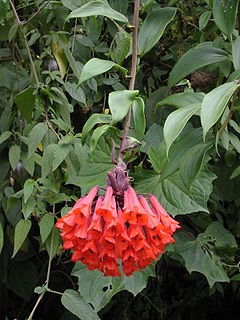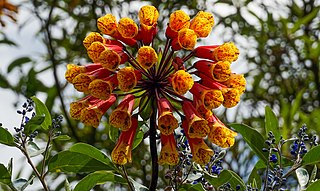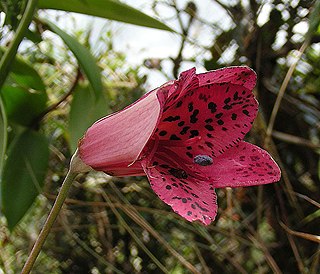
Araucaria angustifolia, the Paraná pine, Brazilian pine or candelabra tree, is a critically endangered species in the conifer genus Araucaria. Although the common names in various languages refer to the species as a "pine", it does not belong in the genus Pinus.

Bomarea is one of the two major genera in the plant family Alstroemeriaceae. Most occur in the Andes, but some occur well into Central America, Mexico and the West Indies. Some species are grown as ornamental plants.

The black inca is a species of hummingbird found only in Colombia. Its natural habitats are subtropical or tropical moist lowland forest, subtropical or tropical moist montane forest and urban areas. It is threatened by habitat loss.

The striolated tit-spinetail is a species of bird in the family Furnariidae. It is endemic to Brazil where it is commonly known as grimpeirinho or grimpeiro because it lives mostly on the canopies of the Araucaria angustifolia pine tree, also endemic to the southern regions of South America.
Bomarea borjae is a species of flowering plant in the family Alstroemeriaceae. It is endemic to Ecuador. It is known only from two collections made in the caldera of the dormant volcano Pululagua over 100 years ago. It is not a well-known species and is threatened by habitat loss.
Bomarea brachysepala is a species of flowering plant in the family Alstroemeriaceae. It is native to Peru and Ecuador. It grows in mountain forest habitat in the Andes. It is threatened by destruction of habitat caused by deforestation and mining.
Bomarea ceratophora is a species of flowering plant in the family Alstroemeriaceae. It is endemic to Ecuador, where it is known from only two collections.
Bomarea chimborazensis is a species of flowering plant in the family Alstroemeriaceae. It is endemic to Ecuador. It is a plant of páramo habitat. It is threatened by fires set by people.
Bomarea elegans is a species of flowering plants in the family Alstroemeriaceae. It is endemic to Ecuador, where it occurs in the forests and páramo of the Andes. It is threatened by fire, grazing, and mining.

Bomarea glaucescens is a species of flowering plant in the family Alstroemeriaceae. It is native to Peru, Bolivia and Ecuador. It grows in wet páramo habitat among Polylepis and next to lakes, as well as grassy páramo and Andean forests. It is not a threatened species but some populations are vulnerable to habitat destruction as the páramo is converted to pasture and pine and eucalyptus plantations.
Bomarea goniocaulon is a species of flowering plant in the family Alstroemeriaceae. It is native to Peru and to Ecuador, where it has been collected only three times in the Pichincha Province. It is known from mountain forest habitat.
Bomarea gracilis is a species of flowering plant in the family Alstroemeriaceae. It is endemic to Ecuador. It grows in forest and páramo in the Andes.
Bomarea graminifolia is a species of flowering plant in the family Alstroemeriaceae. It is endemic to Ecuador, where it has only been collected once, before 1908. The specimen probably came from the forests on the volcano Atacazo, near Quito.
Bomarea hartwegii is a species of flowering plant in the family Alstroemeriaceae. It is native to Peru and to Ecuador, where it has only been collected twice, in the Pichincha Province. It is threatened by habitat destruction.
Bomarea lanata is a species of plant in the Alstroemeriaceae family. It is endemic to Ecuador. Its natural habitat is subtropical or tropical moist montane forests. It is threatened by habitat loss.

Bomarea longipes is a species of plant in the Alstroemeriaceae family. It is endemic to Peru and Ecuador. Its natural habitat is subtropical or tropical moist montane forests. It is threatened by habitat loss.
Bomarea lutea is a species of plant in the Alstroemeriaceae family. It is endemic to Ecuador. Its natural habitat is subtropical or tropical moist montane forests. It is threatened by habitat loss.

Bomarea uncifolia is a species of plant in the family Alstroemeriaceae. It is endemic to Ecuador. Its natural habitat is subtropical or tropical moist montane forests. It is threatened by habitat loss.

Malus angustifolia, or southern crabapple, is a species of crabapple native to the eastern and south-central United States from Florida west to eastern Texas and north to New Jersey, Pennsylvania, Illinois and Missouri.
Anoura peruana is a species of bat from Colombia and Peru. It was elevated to a species in 2010, after previously being considered a subspecies of Geoffroy's tailless bat. The females are larger than the males.
This page is based on this
Wikipedia article Text is available under the
CC BY-SA 4.0 license; additional terms may apply.
Images, videos and audio are available under their respective licenses.








